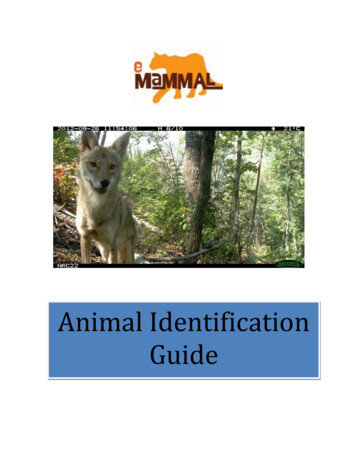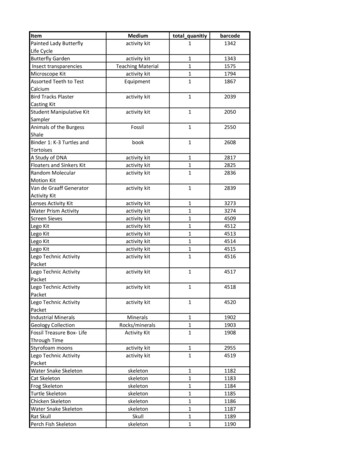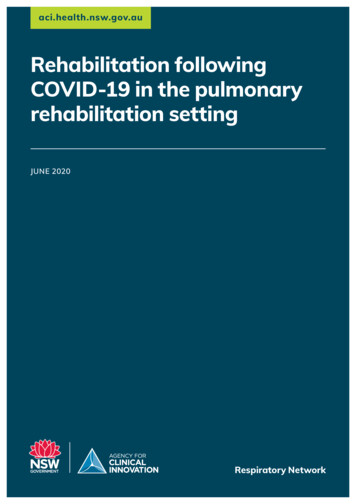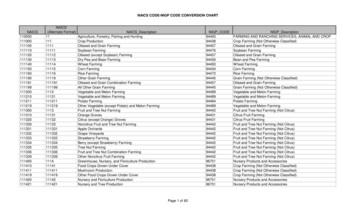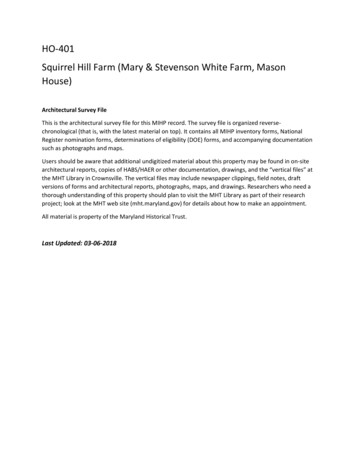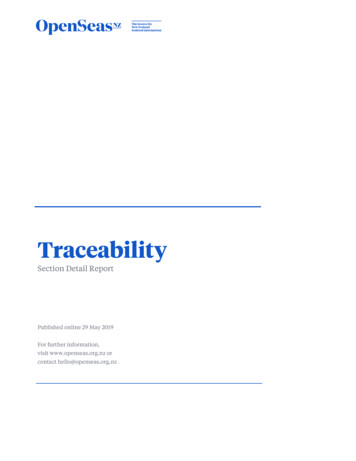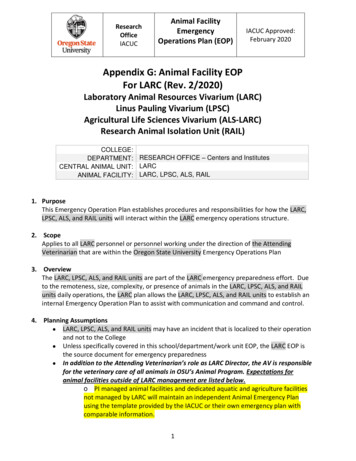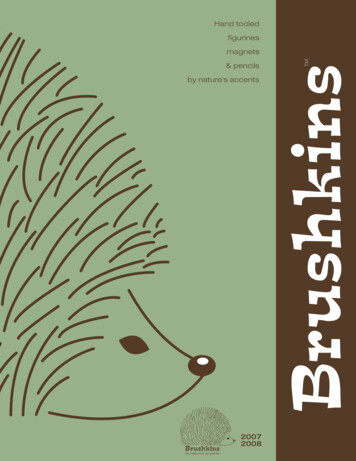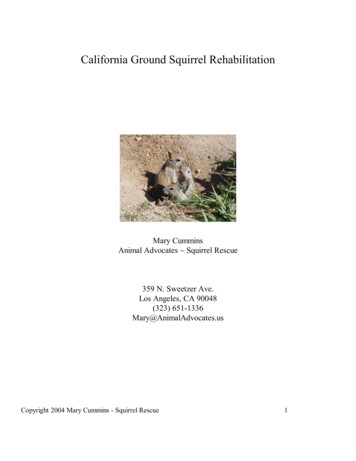
Transcription
California Ground Squirrel RehabilitationMary CumminsAnimal Advocates Squirrel Rescue359 N. Sweetzer Ave.Los Angeles, CA 90048(323) 651-1336Mary@AnimalAdvocates.usCopyright 2004 Mary Cummins - Squirrel Rescue1
California Ground Squirrel RehabilitationRehabilitating ground squirrels is very similar to rehabilitating tree squirrels except the caging needs and releaseare quite different. Their diets are only slightly different. Very young infant ground squirrels are rarelyencountered due to the fact that the nesting chamber is deep inside the burrow. The only time very young babiesare found is during deeper ground excavation for construction or landscaping. Orphans will generally only befound above ground after their eyes have opened and they can crawl out of the burrow if mom has died and theyare hungry. When they first emerge from the burrow and venture out on their own is when they get into the mosttrouble with cats, dogs, hawks and cars. After the first wave of orphaned babies you will then get a wave ofinjured juveniles that have generally been brought in by the cat or dog.DescriptionCalifornia Ground Squirrels (Spermophilus Beecheyi) are one of a few native ground squirrels in California. Theyare found as far North as Washington and as far South as Mexico. They are about 14-21 inches long (36-51 cm)and weigh about 10-26 oz. (280-740 gm). They are mainly brown with paler dapples. They have a pale V-shapedarea of fur at the neck running over each shoulder that looks like a white spotted stole. In the wild they generallylive about three years but in captivity can live up to ten years.HabitatThey are found in low elevations on our coastal beaches, mid-elevation in local city parks and in high elevationmountain and field areas. They will always be located very close to the food source be it natural foods, crops ortourist handouts. They generally never stray more than 75-100 ft. away from their burrows so they can alwayshave a safe burrow to hide in from predators. Where there are large colonies of ground squirrels you will alsofind their natural predators which are coyotes, hawks, snakes, weasels and foxes.Copyright 2004 Mary Cummins - Squirrel Rescue2
BurrowsThey are not as social as most ground squirrels so they can live alone or in informal colonies. When in colonies,each member has it's own entrance to the colonial burrow underground. When a predator approaches eachsquirrel scurries to its own entrance rather than use another squirrels entrance that might be nearer. Their burrowincludes two entrances/exits, a hibernation chamber, summer sleeping chamber, nesting chamber, food cachechamber and sometimes an elimination chamber. They prefer to build their burrows in softer ground on anincline. When they build their burrow next to the ocean, they can plug the entrance and exit holes during hightide to prevent their burrow from being flooded. They also plug their burrow holes during winter hibernation.BreedingCGS generally breed once per year soon after they emerge from hibernation. The older females breed earlier thanthe younger females so you may see two waves of young. Sometimes they will breed twice a year if theirhibernation period is short or nonexistent. The gestation period is approximately 30 days and they usually have 68 babies per litter. As CGS at lower elevation generally emerge earlier from hibernation, they will have litters 30days after emergence which can be from April to May. The second wave will be seen from June to July.DevelopmentBirth: Hairless, pink with barely noticeable whiskers, blind, no eye slit, ears tightly closed, weight 5-8 gm, cancrawl slightly and squeak.Day 3: Pigment begins to appear, starting at the head and progressing down the back.Day 7: Well pigmented, short fur begins to grow, more active.Day 14: Lower incisors eruptDay 17: Well furred, more coordinated crawling, upper incisors emerge4 weeks: Eyes open. Weight about 40-45 grams.6-10 weeks: Begin to emerge from burrow. Females will nurse young for 7-8 weeks. Almost a week afteremerging from the burrow they can forage on their own. Weight about 90 grams.14-18 weeks: About 90% of their full size.Natural dietCGS at different elevations and in different habitats will have different diets. When located on beaches they willsurvive mainly on tourist handouts along with seaweed, natural grasses, carrion, grains and seeds. When locatedin more natural surroundings their diet will consist of nuts, seeds, grains, berries, fruits, roots, green vegetation,cactus, carrion, eggs and insects.Diet in rehabilitationCopyright 2004 Mary Cummins - Squirrel Rescue3
Infant: The infant CGS diet is similar to the infant tree squirrel diet. A variety of formulas may be used includingEsbilac, Fox Valley and Zoologic Milk Matrix mixed as instructed.Weaning: Add powdered rodent blocks or high protein baby cereal to formula soon after their eyes open. Smallamounts of soft fruits and vegetables, small pieces of rodent block and grains may also be offered.Post-weaning: Rodent blocks and Zupreem monkey chow biscuits can be used as the staple diet to insure propernutrition. 30% of the remaining diet may be fruits, vegetables, grains, seeds, berries and some nuts. CGS lovebroccoli. They may also be offered crickets, grasshoppers, mealworms and small bits of meat prior to release. Igive them small bits of cooked chicken.Wild adults: They may not be interested in rodent blocks or monkey chow. Offer them the natural diet with avitamin mineral powder or liquid mixed into the food or water. If they cannot chew, you can offer them Ensurepecan flavor, applesauce mixed with Nutrical, powdered rodent blocks/chow mixed with water given through asyringe.Below is a chart comparing different formulas and milks.Type of milkEastern grayBen ShaulJenness & SloanNixon & HarperMilk 3.3% fatGoats milk, freshEvap. milk canKMR liquidEsbilac 1:2Esbilac 70.610.71.060.80.91.8Dehydration and fluid therapyAlways allow a newly arrived squirrel to reach a normal body temperature before giving any fluids or food. Thesquirrels organs cannot process food or fluids until they are warmed. If food or fluids are given to a very coldsquirrel, they will not have the energy to process it and may die.Assume all squirrels are dehydrated upon arrival. These are some signs of dehydration: pale, grayish gums, drymouth, sunken eyes, whites around eyes showing, rough, spiky fur, dry scaly skin.Some rehabbers use the "tent test" to check for dehydration. Gently pinch a small amount of skin between twofingers to form a tent. If the skin quickly goes back down, the squirrel is hydrated. If the "tent" is still evidentafter a second or two, the squirrel is dehydrated. This is not always reliable with baby squirrels because they gothrough a wrinkly stage where they look like Sharpei puppies. Be sure to look at all indicators and don't rely onany one indicator to test for dehydration.Copyright 2004 Mary Cummins - Squirrel Rescue4
Oral administration of fluids is the easiest and fastest way to re-hydrate. Subcutaneous (Subq) injections of fluidsshould generally only be done if the animal is unable to swallow. Subq can cause additional stress to an alreadystressed animal. Legally you must consult a veterinarian for guidelines on the amounts of fluids to be injected andthe frequency. You can introduce fluids orally even in an unconscious squirrel with proper technique. Place onedrop at a time on the tongue of the squirrel and wait for the swallow reflex action.I personally believe the best hydrating fluid to give to a warmed baby is Lactated Ringer's Solution for the firstfew feedings. You can get Ringers from your local veterinarian. Pedialyte, Gatorade and other over the counterhydrating solutions can have too much sugar or dextrose which will actually cause more dehydration. Do not usea solution with more than 2.5% dextrose for initial hydration. You can use these fluids for hydration maintenanceafter they are fully hydrated. Make sure all hydrating fluids and formulas are first warmed so they feel warm tothe touch but never hot, about 100-102 deg. F.Introduction of formulaA baby should never instantly be fed full strength formula. This can cause digestive problems because it is notexactly the same as mothers milk or the baby may not have eaten in quite a while and not yet able to processfoods. After he is warmed and hydrated you should slowly introduce formula mixed with the hydrating formulaover a days time gradually increasing the ratio of formula to hydrating solution until the baby is on full formula. Isuggest the following ratios for a warm and hydrated baby.Feeding 1 100% hydrating fluidFeeding 2 75% hydrating fluid 25% formulaFeeding 3 50% hydrating fluid 50% formulaFeeding 4 25% hydrating fluid 75% formulaFeeding 5 100% formulaIf the squirrel develops bloat, diarrhea or constipation, go back to hydrating fluid only then slowly try tointroduce the formula again, this time more gradually. The stools when feeding Esbilac formula should begolden-yellow, firm and well formed. If they become whiter or loose, cut back on the amount of formula until thestools are well formed again. If the baby has diarrhea for over 24 hours, consult a veterinarian. Initially the stoolsof a baby may be dark which is the normal stool color if fed mothers milk or the goats milk recipe.Feeding instrumentsYou can use an oral syringe (without a needle) to give fluids orally to a squirrel. I suggest a 1/2 cc syringe forpinkies (with or without a nipple depending upon your preference and the squirrels), 1 cc syringe for squirrels 25 weeks of age and 3 cc syringe for all other squirrels for initial hydrating purposes. You can use up to a 5 ccsyringe to feed larger older babies. I do not recommend any larger as it's easy to aspirate babies especially withlarger syringes if they're real hard sucklers. It's better to fill up a few 3 cc syringes at a time then one 5 cc orlarger syringe.If using a nipple, I suggest the catac nipple. If feeding a very small newborn pinkie squirrel, one can use a tom catcatheter or super glue attachment nozzle attached to the end of the syringe to control the amount of formulabetter. I do not suggest using pet nursers/bottles because it's more difficult to control the amount of formula.Everyone should use what works best for them and their squirrels. See appendix for where to find these supplies.Below are photos of various feeding instruments.Copyright 2004 Mary Cummins - Squirrel Rescue5
Feeding techniqueWhile holding the baby upright but leaning slightly forward with the oral syringe angled slightly upward andforward to form a 90 degree angle with the baby, you can place the tip of the oral syringe right to the babies lipsthen gently and slowly squeeze one drop for them to taste. (Photo below) When babies are 4 weeks of age andolder they may prefer to lie prone on their stomachs while grasping the syringe in their paws. They may start tomake suckling, licking or lapping motions with their mouths and tongue then you can slowly squeeze out moredrops of fluid. Do not squeeze out a regular stream, instead squeeze a tiny bit then allow them to swallow thatamount before squeezing more. With pinkies I go drop by drop because they are so easy to aspirate, i.e. to takefluids into the lungs by suction. If they become aspirated, they can die of pneumonia without proper treatment.Proper treatment is the use of antibiotics, generally Clavamox liquid. With older babies I will squeeze fluid slowlyfor one second, let them swallow that, then squeeze more. If fluids dribble out the mouth or come out the nose,you are going too fast. If fluids come out the nose, stop feeding immediately, hold them upside down for a fewseconds, blot their nose with dry tissue paper then let them wait a few minutes before resuming feeding.If the baby does not immediately suck, lick or lap the fluid, you can gently place the tip of the syringe into theirmouth. It's sometimes easier to enter from the side of the mouth especially if they already have teeth. Then gentlysqueeze out a drop of fluid into their mouth for them to taste. It sometimes takes a feeding or two for them tocatch onto the new feeding method.Feeding amount and frequencyThe following chart should be used as a guide for feeding baby squirrels. A good rule of thumb for maximumCopyright 2004 Mary Cummins - Squirrel Rescue6
volume amount to feed per feeding session is 5% of the squirrel's body weight in grams (Sedgwick et al. 1988).This is approximate maximum stomach capacity. One half to 3/4 of the maximum is a safe amount to feed. Besure to weigh your squirrel frequently to be able to adjust the amount of food needed and make sure that it isgaining weight.Age0-2 weeks3-4 weeks4-5 weeks5-6 weeks# daily feedings6-8643Frequency2-2.5 hrs 1 at night3-4 hrs 1 at night opt.4-5 hrs no night4-5 hrs no nightTypeFormulaFormulaFormula and foodFormula and foodBesides maximum stomach capacity you need to consider their total daily caloric needs. One way to figure thisout is by using the Minimum Energy Cost (MEC) formula which is K x W (in Kg) to the .075 power, where K iskilocalories utlilized in one day by a hypothetical 1 kg specimen. Squirrels are considered placental mammals andtheir K factor is 70. All of this is multiplied by a factor to get their total daily caloric needs. A growing babysquirrel has a Base Metabolic Rate (BMR) of 3, sometimes 4. If they are injured or overcoming illness it willprobably be 4. As this is a basic class, no need to pay attention to the math. In the back of this manual are chartswhich figure everything out for you based on the weight of the baby using Esbilac formula mixed 1:2 and 1:1. Asyou can see Esbilac mixed 1:2 with water by itself does not have as many calories per cc as squirrel mothers milk.You would have to feed almost twice as many times a day as the schedule above. Mixed 1:1 feeding the baby themaximum stomach capacity will make the number of feedings be more in line with the chart above. I don’tsuggest this as it may be too rich and may not provide enough fluid. This is why some people like to addwhipping cream, rodent block dust and other things to the basic formula. All of these numbers, charts, recipes aremerely guidelines. If your baby is urinating, defecating and growing normally, you are feeding him properly.For proper development squirrels need the proper Calcium to Phosphorus ratio. It must be 2:1 for infants, 1:1 foradults. If the baby does not get enough calcium or not in the proper ratio, they can develop Metabolic BoneDisease (MBD). It’s easy to add the necessary Calcium by grinding up Calcium tablets into dust and adding it totheir food.As soon as their eyes open and they're moving around at 5-6 weeks or so I introduce 1/2 inch square pieces ofsoft food such as avocado, apples and grapes. If you give them grapes, you must peel it for the little babies or theskin will get stuck in their throat and they'll gag. If you get big Globe grapes, they're real easy to peel andcheaper.They will generally just chew on and play with their food in the beginning which is fine. If they are having aproblem adjusting to regular foods you can slowly add apple sauce, pulverized rodent blocks or baby cereal totheir formula to make it thicker. If using the rodent blocks, put them in a coffee grinder to turn it into dust so itdoesn't stick in a syringe.When they are around 6-7 weeks of age I start to introduce harder foods such as bits of carrot and small piecesof rodent blocks. I will also give them some shelled almonds so they can learn how to chew on things. They willgenerally just chew some of the food up and not eat it which is fine. When the formula feedings decrease, Iincrease the amount of soft and harder foods until they are totally weaned around 10 weeks or so. Then I givethem breakfast and dinner of hard and soft foods. Get them used to normal squirrel feeding times by feeding themwithin a couple of hours after sun up and within a couple of hours before sun down. Some squirrels may refuseformula at 6-7 weeks of age, some will still beg for it at 10 weeks of age which is within the realm of normal.Copyright 2004 Mary Cummins - Squirrel Rescue7
Below is a list of some acceptable foods for squirrels. As with everything be sure to introduce new foodsgradually. Some squirrels can get bloody diarrhea if they eat an entire walnut for the first time while others canget green soft stool from eating too much avocado. I always try to make sure that there is a little food left overso I know that they're all eating enough. Use nuts and seeds as treats only or they will get fat.Fruits and veggies: grapes, cherries, apple, melon, tomato, avocado, butternut squash, orange, broccoli, endive,turnip greens, cucumber, okra, green bell pepper, raw corn on the cob, pear, green bean, sugar pea, sweetpotato, spinach, mustard greens, carrot, carrot tops, raw soy bean, plum, banana, kiwi, mango, strawberry,strawberry tops, buck eye, blueberry, blackberry, raisin, fig, date, peach, nectarine, apricot to name a few. Nutsand seeds: pine nuts, acorns, pine cones, sunflower seeds, peanuts, walnuts, pecans, hazelnuts; sun driedwatermelon, cantaloupe, squash and pumpkin seeds. They also like fresh rosemary, fresh lavender and rose petalclippings. Ground squirrels getting ready for release and adults also like a tiny bit of cooked chicken.Feeding tips and tricks Mix the powdered formulas with a fork and not a blender. The blender will get too many bubbles in theformula.Mix only the amount you will use that day. Warm only the amount you will feed that feeding session.Always make sure your hands are warm before handling babies.If the plunger of the syringe should stick, use a tiny bit of olive or mineral oil to keep it moving smoothly.Always clean the syringe out with hot water after each use to sterilize. I also use a pipe cleaner to clean outthe hole if any formula accumulates. Let the syringe dry with the plunger out to make sure the syringe driescompletely.When babies are eating solid foods and drinking from water bowls, use thick glass or ceramic ashtrays orcrockery. Do not use plastic dishes which they will chew up.When feeding large numbers of babies, you can place the formula in a coffee cup on a heating cup warmer.Just be sure to keep babies away from the warmer.To keep track of large numbers of babies, after feeding and stimulating each baby, place it into a newcontainer so you can be sure to feed all babies without feeding some babies twice.I like to put the baby on a piece of fake fur to feed so it feels more natural. I also put a little fabric under themiddle of the fake fur piece so it will feel more like the natural nursing position if he were nursing on hismother. They feed similar to kittens with mom rolling over half on her back. It also makes it easier to get thesyringe to his mouth properly.If you are feeding a lot of babies, try not to hunch down and over. Raise the feeding platform if necessary oryou will get a bad neck ache.Learn how to refill a syringe with just one hand so you can always have one hand on the baby. Never leave ababy unattended, even for a second. They can roll or crawl off the table just like human babies.Urination and defecationAlways stimulate baby squirrels after each feeding. Some may require stimulation before feeding. If a squirrelstops eating in the middle of feeding, it may need to be stimulated before continuing to feed. Use a warm, dampcotton ball, tissue or q-tip and gently pat the genitals until urine or stool is produced. You can use a slightdownward stroke above their genitals to help them produce urine. You can gently press directly around the anusto help them produce stool. Be sure they are urinating and defecating at least every other feeding. Initially theymay not produce much urine if they are dehydrated. They may not produce much stool if they were not fed for aCopyright 2004 Mary Cummins - Squirrel Rescue8
while. Don't be alarmed if they do not produce stool the first day if they were separated from their mother for awhile. Generally babies will urinate and defecate on their own soon after their eyes open. If baby does not,continue to stimulate.Body part sucklingIt's fairly common for baby squirrels to suck on the penises, vulvas, heels, knees, elbows, noses, stomachs of theirlitter mates. The urge to suckle is very strong. In nature mother squirrel probably lets them suckle longer than wenurse them. If you see red and inflamed body parts, they are probably suckling each other. Try to feed them moreoften, more slowly and longer to satisfy their natural suckling instinct. If they are older, give them some harderfoods to chew and suck on. If it's just one baby which is doing all the suckling, remove that squirrel to anotherarea. If he is suckling himself, treat his penis with petroleum jelly or neosporin. You can also spray some bitterapple on his penis which may reduce the suckling. Extreme cases of suckling may result in scabbing and blockageof the urethra. If the scab blocks the flow of urine, it must be removed. This can be accomplished by soaking thescab for 15-20 minutes with a wet cotton ball until the scab turns white and slides off easily. If the penis is justvery swollen, an antibiotic ointment containing steroids such as Panalog or Animax will help reduce the swelling,so will preparation H. If the baby still cannot urinate after trying these suggestions, consult your localveterinarian for other solutions.HousingInfants may be kept in a pet carrier, aquarium, terrarium or small wire mesh cage with a heating pad set on lowunder half. Give them soft fabric with no holes or string in which to nest. An incubator set at 90 deg. F with 7080% humidity is even better for very young infants. You can use a stick-on reptile thermometer in the incubator.An incubator can be made out of a 10-20 gallon Tupperware container with ample holes in the lid or a hold cutout of the lid with wire mesh inserted so they cannot escape. Drape a towel over the container to simulate thenatural darkness of a burrow.As soon as their eyes are open and they can crawl around you can transfer them to a larger cage about 2' square.You can place this cage into a deep metal pan so that you can fill the bottom with dirt, or you can just useshredded newspaper and fabric. If you do not have a deep pan, just be sure that you provide them with a nest boxand tubes to use as an artificial burrow. You can use paper towel tubes for young babies, wider PVC and plastictubes for older squirrels. Pet safe ones at the pet store are safer than ones in the plumbing department of yourlocal hardware store. As soon as they are weaned they can go to a larger outdoor cage 4’x4’x6’ so they can getready for release. Continue to provide them with a wheel, probably a larger one as they grow. Some people burythe lower two feet of the cage into the ground so they can dig in natural dirt and build a natural burrow.Infant squirrels of the same age from different litters may be raised together. Groups of no more than eight canbe raised together. You should never raise a solo squirrel as they need to learn how to socialize, play and canbond too strongly to their caretaker. Call around and find someone with other squirrels of a similar age forcompanionship.Injured adults should initially be housed in small wire mesh cage with a smooth floor or a pet carrier with a metaldoor that is also reinforced with wire mesh inside. CGS can chew out of a plastic carrier in about 20 minutes. Ifyou must treat the squirrel daily, just give it lots of soft fabric to make a nest. If you don't have to treat itanymore, give it a nest box with a tube to hide in. Removing an adult ground squirrel from its nest box can bedangerous because they will bite. That's why it's easier just to grab them with the fabric nesting material to holdCopyright 2004 Mary Cummins - Squirrel Rescue9
and treat them. Bite proof gloves are a good idea but you will still get a bad bruise from the force of their jawson your finger. They can also get through some bite proof gloves so do not rely on the gloves. Rely on properholding techniques as discussed later.Keep your caging away from the sight and sound of humans and pets so they do not become too accustomed.Limit handling of the squirrels to the bare minimum for feeding and examination only. Do not talk to yoursquirrels. You do not want them to become bonded with you, the caretaker. You do not want them to seek outhuman contact when they are released. If they come up to a human after release and that human thinks thesquirrel is trying to attack them, they may kill the squirrel.Minimum Fish & Game requirements for ground and rock squirrels as per minimum standards third edition 2000are below. CGS are not regulated by Fish & Game so these are just guidelines. If the squirrel is injured, you canconfine them in a smaller cage or carrier to limit mobility so they will not injure themselves.Infant care(Litter) 10-GallonNursing/preweaned(Litter) 20 GallonJuvie or adult outside(L) 4'wide x6'long x6' tallInit. injured adult inside(1) 2'wide x2'long x2' tallReleaseGround squirrels that do not hibernate may be released at any time providing that there will be a couple of daysof good weather so they can find, renovate or build a burrow. Ground squirrels that hibernate must be releasedwell before their hibernation so they can gain weight, cache food and prepare their hibernation burrow. Higherelevation CGS should be released at the latest by August 1, lower elevation by September 1 if they hibernate.CGS are regulated by the Department of Agriculture. They are legally considered agricultural pests. CGS cannotbe relocated without a permit. They must be released back where found. Release them on the edge of the colonywhere found. CGS are not as social as most ground squirrels but they may not immediately accept an outsider.They have scent glands on the side of their face. When they greet each other they smell each other and can tellhow related they are to each other. They are more receptive to a squirrel more closely related to them.If you cannot release the squirrel in sufficient time before hibernation, you will have to hold him over the winter.Put the squirrel in a dark covered cage with a nest box. Provide with food and water but you will probably onlysee them eat every few days. They will sometimes even go to sleep with food in their pouches so they can eatwithout having to get up. They will not truly hibernate indoors but will seem to stay in a state of deep sleep fordays at a time.Release the squirrel after other squirrels have been seen above ground in its colony so the squirrel may haveproper breeding opportunities.There are a few ways to release ground squirrels. Some believe in tough love and just place a carrier on theground in a protected area such as a bush on the edge of the colony. Then they wait for the squirrels to leave thecarrier or they gently nudge them out. Sometimes they can become stressed and instantly take off running. If youare anywhere near cars, do not do this. Some will place them in a cardboard box with air holes and a door flap inthe same place. This way they can leave when they choose and the box is biodegradable. Some build a burrowfor them underground. Dig a hole approximately 1.5 ft. deep. Place a nest box or cardboard box with a front arear hole into the ground. Get two large paper role tubes with diameters at least 2 inches. Make sure the inside ofthe tubes is grippy enough so they can climb up the tubes at an angle. Place one tube in one hole and attach withCopyright 2004 Mary Cummins - Squirrel Rescue10
duct tape. Do the same with the other hole and tube. Bury the nest box and tubes leaving just the tube holesexposed. Place the squirrels into the tube and they will run down into their new burrow. They will use this as atemporary burrow until they find, renovate or build a new burrow. Some leave food in the nest box, some do notfor fear of attracting predators.Illness and InjuryIf the squirrel is ill or injured and able to at least crawl, he will generally crawl back to his burrow to die which iswhy we don't get in many ground squirrels as compared to tree squirrels. The most common illness and/or injuryin juvenile and adult ground squirrels is being caught by a cat, dog, hawk or other predator. Second is being hitby a car, third is rat and ground squirrel poison. The most common ailments in baby ground squirrels are beingaspirated by the rehabilitator while nursing, diarrhea from overfeeding or constipation from inadequate hydration.Adult ground squirrels will generally try to bite. They can bite through leather and bite resistant gloves. Restrainthe squirrel by wrapping tightly in a towel or soft cloth. Grip the head just behind the jaws with thumb andforefinger of one hand. This way they cannot whip around and bite you. Covering the eyes will make them feelmore secure. Administer medication with oral syringe. After treatment return squirrel to its cage and then unwrapthe body before releasing the head hold.When first booking in a new animal provide care in the following order.1. Treat life threatening wounds. Apply pressure and wraps to stop bleeding and temporarily set injured limbs.2. Warm. If they are not warm, their organs will not be functioning properly and they will not be able to absorbor process fluids, medication, food and they can die of shock. After treating life threatening injuries, place themin a warm, dark, small cage in a quiet area so they can relax and feel more secure for 30 minutes to an hour.3. Hydrate. If they are not hydrated, they will not be able to absorb or process foods.4. Begin to feed. Introduce food to them slowly and gradually especially if they are extremely e
the frequency. You can introduce fluids orally even in an unconscious squirrel with proper technique. Place one drop at a time on the tongue of the squirrel and wait for the swallow reflex action. I personally believe the best hydrating fluid to give to a warmed baby is Lactated Ringer's Solution for the first few feedings.
